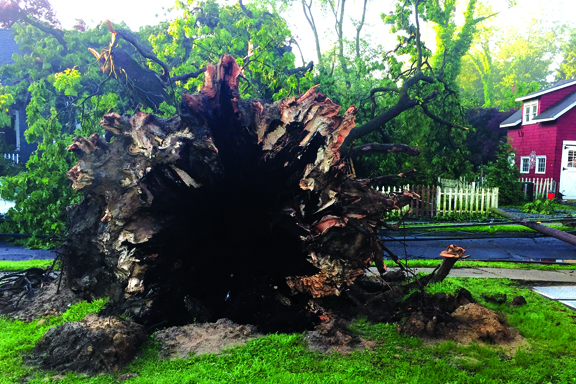Shade Tree review of June 3 storm

On June 26, 2020, the Borough published the following statement on its website.
Shade Tree Commission Review on June 3, 2020 Storm
On June 3, Haddonfield experienced 2 storms that took down many trees, both public and privately owned, created significant damage throughout town, and left over one-third of our residents without power. While our Department of Public Works (DPW) continues the cleanup from these and other storms, here is a summary of what happened that day, what the Borough is doing to mitigate the future impact of similar events, and actions you, too, can take regarding your private property.
The 2 storms that day were significant wind events. Twenty-four Borough-owned street trees fell due to unusually strong wind gusts, including 3 trees brought down when larger trees fell against them. Another 4 trees were subsequently taken down as DPW inspections indicated that they were starting to uproot. Five to ten more street trees will be taken down over the next months, as DPW inspections showed that they will not survive the extensive storm damage to their canopy, trunk or root structure. This does not include the additional trees that toppled in our public park spaces. Finally, although the Borough does not track trees growing on private property, we know that many privately-owned trees came down in the storm or are being removed due to damage.
Weather reports classified these storms as “derecho,” an unusual, long-lived, straight-line wind storm associated with fast-moving severe thunderstorms. Furthermore, this spring alone, there have been at least 2 other damaging storms: the first, in April, brought down more than 15 public and privately-owned trees in the Tavistock, Greenmount and Concord Drive area; and another this past weekend when 3 street trees fell, at least 3 private trees came down onto our streets and utility wires, and countless branches lay scattered on the roads.
What is going on? These recent storms have brought down many younger, healthy trees. When a tree is in full leaf, its canopy acts as a sail, resisting unusually strong, continuous straight-line wind gusts until it can no longer. Then, limbs break or trees go over. Like hurricanes, other storms that move up our coast from the south, pose further challenges. The trees have grown to resist the usual prevailing winds from the west but coastal storms push and twist the trees in new directions. The June 3 storms brought down one of our oldest trees, the Black oak growing on the water plant property on Lake Street, and one of our youngest, the 2017 Arbor Day Honey locust tree growing by the Central School playground. The Black oak was felled by the strong winds; the Honey locust was simply blown in half.
Residents need to evaluate and manage the trees on their own property. Learn to identify your trees, particularly the oaks and ash, so that you can monitor their condition. If you hire an arborist to advise you, make sure that the arborist is either ISA-certified or is a NJ-licensed LTE (Licensed Tree Expert). While you will need an arborist if you decide to lighten the canopy of a large tree, you can also help by removing any evergreen English ivy growing up its trunk and into its canopy. Non-native English ivy weakens and kills trees by preventing sunlight from reaching the tree’s leaves, weighing down branches in wind or ice storms, and encasing the trunk so that the tree bark begins to rot. Finally, if you are taking down a tree, please look at the Recommended Tree Planting Species List on the STC webpage for suggestions of small, medium and taller hardy native trees to support our birds and native wildlife, help us shade and cool our air and enhance the economic value of our properties. The Tree Care section of the Haddonfield Shade Tree Commission webpage on the Borough website will have more information within the week on tree identification, ivy removal, pruning mature trees and recommended trees to plant.
The Borough is working to address this new climate-based challenge to our trees. Currently, the Borough removes on a planned basis 150 to 200 trees annually, relying on DPW inspections, observation and our street tree inventory. Tree removals are now the primary job of our Borough tree crew, supplemented by contractors for the largest trees. Ten years ago, we began removing our pin oaks and red oaks as they started to succumb to bacterial leaf scorch. Several years ago, we started to lose our white ash and green ash to disease and then the ‘exotic’ emerald ash borer insect. With the help of our trained, volunteer Haddonfield Branch Managers, we have twice evaluated the condition of the ash tree population, using this information to guide our tree removal priorities. We know that our Sugar maples, a more northern native species, are failing rapidly due to our warmer climate. Silver maples and Norway maples, popular in the 1950’s and 1960’s as fast-growing replacements for the American elms lost to ‘exotic’ Dutch elm disease, are relatively short-lived species that are being taken down now.
Five years ago, the Borough changed its species and planting policies. We select species that can grow in our warming climate and are not vulnerable to the wide list of current diseases and pests; we have not planted pin oak, red oak and ash for more than a decade. Trees are selected to better fit the planting space, with species that fit in narrower sites and under the overhead electric wires common in Haddonfield. We no longer plant by driveways, close to underground utilities or within corner sightlines. Finally, just as we are planting a wider variety of trees, we are also planting no more than 80 trees annually to spread out our future risk.
Our goal is to ensure Haddonfield’s streets remain tree-lined and safe. The Borough and the Haddonfield Shade Tree Commission know that we must continue to increase our preparedness for the challenges ahead.